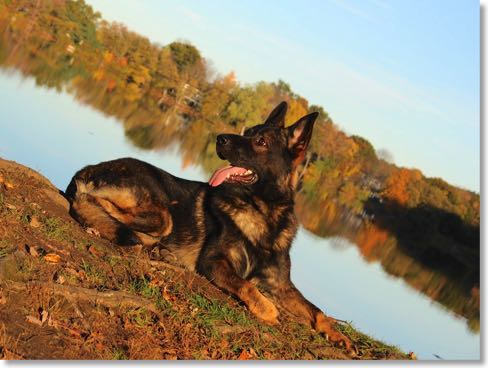Glossary of More Advanced Protection + Obedience Exercises
Guardians like Asterix can do a lot more than smile for the camera.
By Dan Moore
Our sole purpose is to pair families with trained protection dogs that will keep them safe. We do this by taking our training to the extreme, whether it’s fully immersing the dogs in various home and public environments or teaching them the most advanced protection commands possible. In conjunction with our training levels chart, this glossary will help you understand some of the exercises our dogs are capable of.
Heel: Your protection dog stays virtually glued to your leg as you walk, giving you his or her full attention and sitting whenever you stop. Your dog will resume walking when you do.
Relaxed Heel: Similar to the heel command, your dog will stay by your side until released. The difference here is that the dog walks in a more casual way within a three foot radius of your body. This becomes a constant part of our clients’ routines- from walking down a busy sidewalk to taking dogs out to the bathroom.
Down in Motion: Even if your dog is moving at full speed, you can give the word and your dog will drop to a sit or down position.
Place: With this command you have the power to designate a place for your dog to sit or lie down on command. This is a great command to use if you’re having company over and want your dog to keep a low profile.
Food/Toy Refusal: Your dog will wait for your command before taking food or toys.
Turn On Aggressively: In a situation where you need your protection dog to fend off an attacker, you can give the command to “turn on.” Your dog will enter a state of heightened alertness while baring his or her teeth, growling and barking and monitoring the situation. Your dog will await your command and will only actually pursue an attacker if you give the order.
Turn Off: When the situation is defused and you want your protection dog to return to its normal gentle self, you can give your dog the command to “turn off.” Your dog will not show any aggression again until you request it.
Target Parts of Body: We train our protection dogs to go after more than a sleeve or suit, and to be able to leverage their power and fight with technique. If you give your dog the command to attack, he or she will target whichever part of the body will neutralize the threat quickly.
Overcome Obstacles: Our protection dog training takes obstacles into account. From climbing walls, hills, rocks and furniture to jumping out of and into cars and windows, we prepare our dogs to size up a situation and find the best path forward, all while maintaining a tight focus on the threat and any additional commands given by the handler. Exposing our dogs to a variety of obstacles and environments minimizes distraction and improves their response time.
Fighting Skills: Guard dogs and protection dogs may be most known for barking and biting, but our approach is more holistic: we teach our dogs to use their entire body as a tool to fight against a threat. By using a muzzle to remove the option of biting, our dogs learn to tenaciously wrestle, scratch and claw until the handler turns them off.
Turn of Passive Threat: Your dog will turn on aggressively against even a passive threat on your command. A common mistake in protection dog training is to only prepare a dog to go after someone moving in a threatening way. The problem here is that the dog is only conditioned for a very specific set of circumstances. Someone can threaten you without any sudden or imposing movements. Our training is designed so that you can ask your dog to show aggression and deter the threat before they even have a chance to escalate to physicality.
360° Secure: Your dog will turn on aggressively against an attacker (showing teeth, barking and growling) while staying glued to your body in a tight circle, protecting you from attack in any direction. The dog will only bite if you give an additional command, or if the threat attempts to touch you or intrude into this protective barrier.
Guarded Escape: Once you have given your dog the command for 360° Secure, you can walk away from the situation. Your dog will remain in a heightened state of alert until you’re safe and give the command to turn off.
Stealth Mode: Under this command, your dog will be covertly primed for action and waiting intently for an additional command. If you have a gut feeling that you’re in a potentially dangerous situation but do not want to escalate things by turning your dog on aggressively, you can simply put your dog in this standby command.
Multiple Attackers: In the event that there are multiple threats to your safety, you can send your protection dog on a specific person. Your dog will make eye contact with you and follow the signal you give. You can recall your dog at any time, and you can have your dog switch to a different threat mid-bite. By using your judgment and selecting the most prominent threat at any given time, you are given the most control possible in a dangerous situation.
You can see these exercises in action by watching our videos, and be sure to contact us for any additional information.
